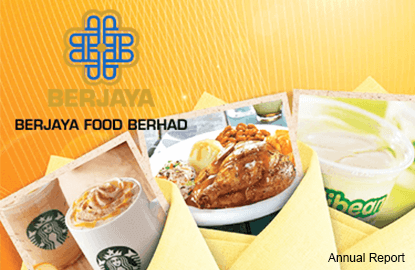
STARBUCKS is not the first franchise business owned by Berjaya Food Bhd (BFood) that has seen a period of aggressive expansion. In the case of Kenny Rogers Roasters (KRR), held under Berjaya Roasters (M) Sdn Bhd, this push came back to bite the roast chicken chain, in combination with other external factors, and dragged down group earnings.
When BFood made its debut on Bursa Malaysia on March 8, 2011, it had 61 KRR outlets throughout Malaysia. That number ballooned to 101 over the following five years or so. For perspective, it took 17 years to reach 61 outlets.
Rising business costs in general have seen Berjaya Roasters’ pre-tax profit fall for at least four consecutive financial years. The biggest plunge during that period was in the financial year ended April 30, 2016 (FY2016). The roast chicken chain posted RM2.5 million in pre-tax profit, down 73.6% year on year. Revenue also fell 10%, the first drop in four financial years at least.
Investment analysts who track the stock are concerned that KRR will continue to weigh down on BFood’s earnings, considering the current soft consumer spending. They opine that the chain may bear the brunt of the weak consumer sentiment more heavily as it is serving the mass market, unlike its sister company Starbucks Malaysia.
But CEO Francis Lee Kok Chuan tells The Edge that he is seeing some light at the end of the tunnel for KRR. “In the last two months, I can see some uptick already for Kenny Rogers,” he says. “There is no more deterioration and same-store sales are rising again.”
In the first week of this month, according to him, KRR saw 9% same-store sales growth, after an 18-month decline. The group has closed two outlets and is assessing the commercial viability of five others.
The turnaround plan, says Lee, is simple — just hang on.
Unlike Starbucks, he opines that KRR is still tied to malls for its captive market for diners. That also scuppered a previous attempt to introduce a tea-time menu to increase sales as restaurant customers do not normally associate places like KRR with having coffee or tea breaks, he adds.
“So, we are going back to basics — spend more on staff training and come up with more value meals to attract customers,” Lee says, conceding that this means sacrificing margins further “to drive traffic”. Another challenge the roast chicken chain faces is the declining footfall in shopping malls.
BFood will refurbish older stores in the next couple of years to give a refreshed look and feel to patrons, according to Lee.
The expected capital expenditure will be in the region of RM2 million to RM3 million a year as the works will be undertaken in stages across the KRR chain.
Despite the shrinking earnings at KRR, Lee believes BFood can afford the refurbishment plan.
“Even with KRR’s profit falling, we’re still cash flow positive. Our cash flow is sustainable, so there is no reason to make a cash call,” he says.
Save by subscribing to us for your print and/or digital copy.
P/S: The Edge is also available on Apple's AppStore and Androids' Google Play.